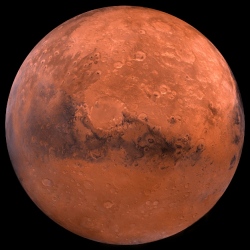
NASA gets all the glory when it comes to Martian exploration, but two other space agencies are now hoping to change that. Early next week, the European Space Agency and Roscosmos are launching the first phase of their joint ExoMars mission, a major new scientific effort to discover signs of life on the Red Planet.
At 8:30 am local time on March 14th, two robotic probes, a Trace Gas Orbiter (TGO) and the Schiaparelli entry, descent, and landing demonstrator, will blast off together aboard a Russian Proton rocket from the Baikonur Cosmodrome in Kazakhstan. Thanks to the close proximity of Earth and Mars at the time of launch, it should only take the ExoMars vehicles seven months to reach the Red Planet, on October 19th.
The mission: to search for evidence of biologic and geologic activity on Mars and to test technologies for the second phase of ExoMars. Exploration will involve an autonomous rover that’ll trundle about the surface drilling holes, collecting samples, and searching for Martian life forms.
“This is really quite a significant mission for us,” Hakan Svedhem, the ESA’s mission scientist for the TGO, told Gizmodo. “It is certainly a possibility that life exists on Mars today, and we are going there to find out.”
So as you might imagine, there’s quite a bit of pride staked on the success of ExoMars. But more exciting still are this mission’s science goals. The TGO is equipped with a suite of instruments that’ll allow scientists to sniff the Red Planet’s lower atmosphere at parts-per-trillion sensitivity. It’ll be looking for chemicals that could signal activity on the surface. Chief among those chemical clues is methane, which remote surveys and NASA’s Curiosity rover have found sporadic evidence for over the past few years.
“Methane is particularly interesting because it can be broken apart by sunlight very quickly,” said Bruce Jakosky of the University of Colorado Boulder, who heads NASA’s Mars Atmosphere and Volatile Evolution, or MAVEN, mission. “If methane is present in the atmosphere at all means it must be resupplied to the atmosphere. That can come about from geologic and biological processes.”
How would we know where the methane is coming from? For starters, we’d have to see what other trace gases are present. Methane in conjunction with sulphur dioxide, for instance, is often taken as a sign of volcanic activity. If methane on Mars is found alongside other hydrocarbons, that could point to a biological source. The TGO is also capable of looking at the ratio of different carbon isotopes present in methane which can help elucidate its origin. But none of these indicators is a silver bullet for alien life.
“Even if methane is from life, it doesn’t mean life is there today,” Svedhem notes. “It could have been stored underground by various processes and is only being released now.”
We’ll need a suite of follow-up analyses to learn the truth. If the TGO sniffs anything interesting, it’ll be able to document the area using a high-res camera and probe the ground for water ice with its on-board neutron detector. If it finds something really interesting, ESA might eventually follow up with a lander.
Jakosky, for one, is excited to see another spacecraft joining MAVEN in the effort to study Mars’s atmosphere. “One of the things we’ve found over the last several decades of exploring Mars is that it’s a very complex system,” he said. “MAVEN is studying the upper atmosphere and TGO will study the lower. If we’re trying to understand the environment as a whole we need measurements from both.”
We’ll also need to continue doing ground-based exploration which is why the ExoMars 2016 payload includes a small robotic lander. Sciaparelli will touch down on Martian soil on October 19th, after which the ESA reckons it’ll have two to eight days of battery life to collect some basic meteorological data.
But mostly, this lander is a proof of concept. The ESA wants to make sure the lander’s heat shield, parachute and thrusters deliver Sciaparelli gently to the surface, because it’s counting on that same technology to bring a large rover to Mars in 2018.
“We’ve never done this full landing concept in the past,” Svedhem said. “There’s a whole sequence of things we need to demonstrate.”
But first things first, these intrepid space probes need to get off the ground. The ExoMars launch will be taking place on March 14th at 8:30 GMT.
